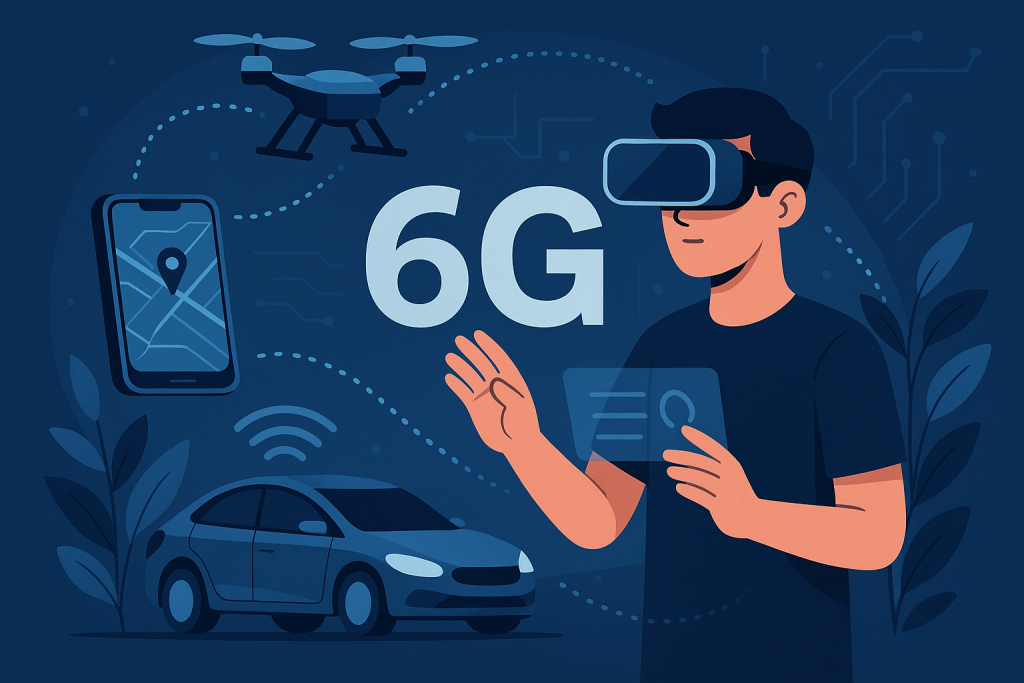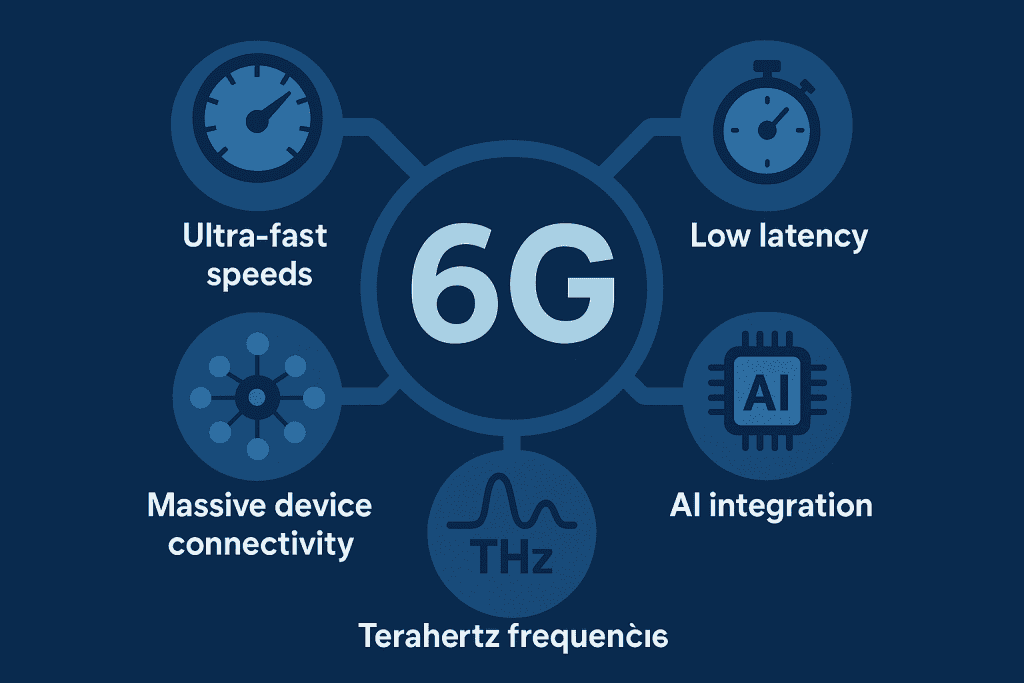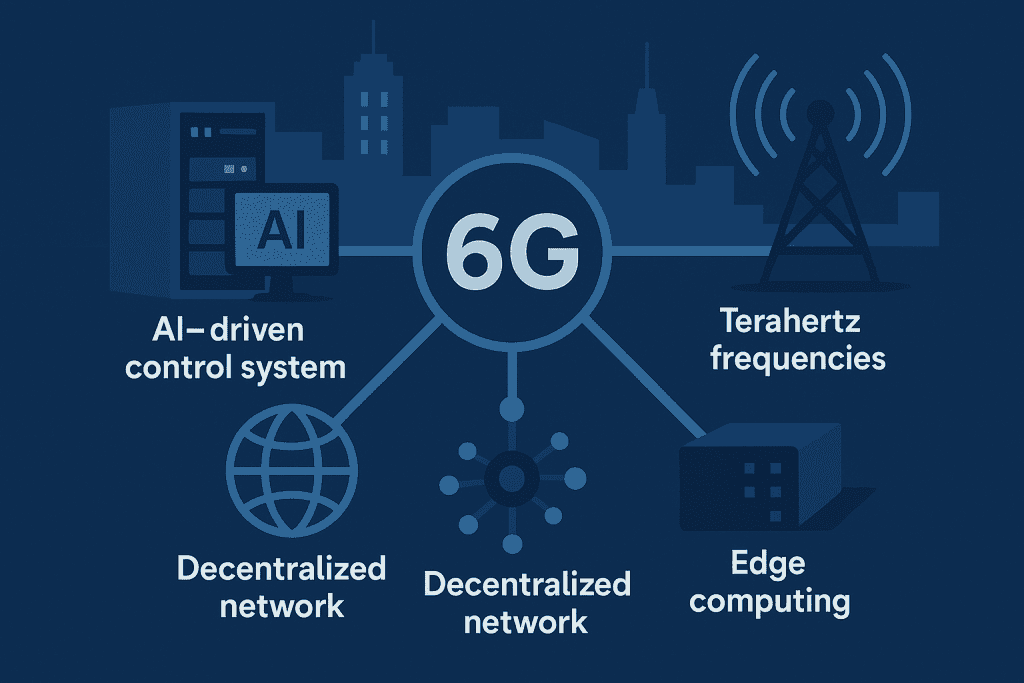
Imagine a world were downloading a full-length 4K movie takes less than a second, where autonomous vehicles communicate seamlessly, and where virtual reality feels indistinguishable from the real world. This isn’t a scene from a sci-fi movie; it’s the promise of 6G wireless technology.
As we stand on the cusp of this technological revolution, 6G wireless is poised to redefine our digital experiences, offering unprecedented speed, reliability, and connectivity.
Overview of 6G Wireless

As we transition from 5G to the next era of wireless communication, 6G wireless stands at the frontier of technological innovation. It’s not just about faster internet. It’s about creating an intelligent, hyper-connected ecosystem that integrates artificial intelligence, real-time responsiveness, and immersive digital experiences into everyday life.
6G aims to push the boundaries of what’s possible, enabling everything from autonomous vehicles and smart cities to holographic communication and tactile internet. Here’s a closer look at the defining features that make 6G wireless a game-changer.
Key Features:
- Ultra-High Speeds: Projected to reach up to 1 Tbps, making data transfer almost instantaneous.
- Low Latency: Aiming for latency as low as 0.1 milliseconds, crucial for real-time applications.
- Enhanced Connectivity: Supporting a massive number of devices per square kilometer, facilitating the Internet of Everything.
- Integration with AI: Leveraging artificial intelligence for optimized network management and services.
- Advanced Spectrum Utilization: Utilizing higher frequency bands, including terahertz waves, for broader bandwidth.
In-Depth Analysis of 6G Wireless
To truly understand the transformative power of 6G wireless, we need to move past the hype and dig into the real innovations driving this next-gen technology. It’s not just about faster speeds. It’s about a complete reimagining of how we connect, communicate, and interact with the digital world. From its advanced architecture and ultra-low latency to its potential to reshape industries like healthcare, transportation, and entertainment, this section breaks down the core elements that make 6G a future-defining force.
Design and Architecture

The design philosophy behind 6G wireless is nothing short of revolutionary. It moves beyond traditional network models to embrace a more intelligent, adaptive, and decentralized architecture, engineered for a world that demands real-time responsiveness, massive connectivity, and seamless integration across digital and physical spaces.
- Distributed Network Systems: Decentralized networks for improved resilience and efficiency.
- Edge Computing: Processing data closer to the source to reduce latency.
- Quantum Communication: Potential integration for enhanced security and speed.
Performance
If 5G impressed you with its speed and responsiveness, 6G is set to leave you speechless. The performance benchmarks being targeted by 6G wireless are not just evolutionary—they’re revolutionary. This next-gen network is designed to deliver jaw-dropping data rates and near-zero latency, creating real-time digital experiences that feel as natural as face-to-face interactions.
- Blazing Data Speeds: With theoretical speeds reaching up to 1 terabit per second (Tbps), 6G could download an entire season of your favorite show in the blink of an eye. This leap is crucial for enabling high-bandwidth applications like holographic video, real-time language translation, and massive-scale simulations.
- Ultra-Low Latency: 6G aims to reduce latency to around 0.1 milliseconds. 100 times faster than 5G. That’s fast enough for precision-critical applications like remote surgery, autonomous vehicle navigation, and industrial automation, where every millisecond counts.
- Hyper-Reliable Communication: Built with mission-critical systems in mind, 6G is being designed to deliver uninterrupted performance even in extreme conditions, ensuring flawless operation for emergency services, defense systems, and smart infrastructure.
Usability
6G isn’t just a technological leap; it’s a user-centered evolution designed to make connectivity feel seamless, intuitive, and immersive. Imagine walking through a smart city where your device automatically switches networks without a hiccup or using real-time augmented reality for remote surgery or immersive education. That’s the kind of experience 6G aims to deliver.
Key aspects of its usability include:
- Seamless Connectivity: 6G is engineered to provide uninterrupted, high-quality service whether you’re underground, in the air, or on the move at high speed. It’s built for true global coverage.
- Personalized Experiences: By leveraging advanced AI, 6G networks can adapt in real-time to user behavior and preferences, tailoring bandwidth, latency, and services to individual needs.
- Energy-Aware Operation: Sustainability is built into the foundation of 6G, with energy-efficient protocols and hardware aimed at reducing the environmental footprint of mass connectivity.
6G Wireless Comparison
While 5G brought significant advancements, 6G is set to revolutionize connectivity.
| Feature | 5G | 6G |
|---|---|---|
| Data Rate | Up to 10 Gbps | Up to 1 Tbps |
| Latency | ~1 ms | ~0.1 ms |
| Device Density | 1 million/km² | 10 million/km² |
| Frequency Bands | Up to 100 GHz | Up to 1 THz |
| AI Integration | Limited | Extensive |
| Energy Efficiency | Moderate | High |
In this concise 3-minute video, viewers are introduced to the fundamentals of 6G wireless technology. The presentation highlights the anticipated advancements over 5G, including significantly higher data speeds, ultra-low latency, and the integration of AI-driven networks. It’s an informative primer for those interested in the future of wireless communication
Pros and Cons of 6G Wireless
As we edge closer to a 6G future, it’s important to weigh its potential advantages against the challenges it might bring. Here’s a quick look at the key pros and cons of 6G wireless technology.
| Pros | Cons |
|---|---|
| Ultra-fast data transmission | High infrastructure costs |
| Minimal latency | Potential health concerns |
| Massive device connectivity | Regulatory and standardization issues |
| Enhanced AI integration | Security and privacy challenges |
| Improved energy efficiency | Technological complexity |
Conclusion
6G wireless technology promises to usher in a new era of connectivity, transforming industries and daily life. Its potential to deliver ultra-fast speeds, minimal latency, and seamless integration with AI positions it as a cornerstone for future innovations.
Best For:
- Tech Enthusiasts: Eager to experience the next level of digital interaction.
- Industries: Sectors like healthcare, transportation, and manufacturing seeking advanced connectivity solutions.
- Developing Regions: Areas aiming to leapfrog existing technologies for rapid development.
6G Wireless Rating
As 6G is still in the research and development phase, a definitive rating is premature. However, based on projected capabilities and potential impact:
Rating: ★★★★☆ (4/5)
Check out what others are saying
FAQ
What is 6G wireless technology?
6G wireless is the forthcoming sixth generation of mobile network technology, aiming to provide ultra-fast data speeds, minimal latency, and seamless connectivity, surpassing the capabilities of 5G.
When will 6G be available to the public?
While research and development are ongoing, industry experts anticipate that 6G could be commercially available by 2030.
How will 6G impact daily life?
6G is expected to revolutionize various aspects of daily life, including enabling real-time virtual experiences, advancing autonomous transportation, and facilitating smart city infrastructures.
References
- Springer. A Survey on 6G Wireless Communication: Requirements, Technologies, and Research Directions
- IEEE Xplore. Towards 6G Networks: Use Cases and Technologies
- MDPI. The Road to 6G: Challenges and Enabling Technologies
- YouTube. 6G Wireless Technology Review
- Twitter. World News No1: 6G Laser Tech Milestone
